Process¶
Lab Development¶
We're currently debating our next steps as setting up a full on biolab for mycelium is quite expensive when you include all the materials. Thus we may expidite the process and buy span and substrate to exelerate our ability to prototype. Special consideration for me is that I will likely be flying back to canada and will need to start all over again there.
Materials for developing biolab:¶
- Pressure cooker (available at BDC)
- Incubator (designed in O/S Hardware)
- Glass Petris
- Alcohol
- Malt Agar
- Scalpel
- Spores/spawn/innoculated substrate
- Parafilm
Sources for setting up our BioLab:¶
- Lab Equipment Darwin
- Substrate
Secondary Research¶
I working on building a central hub for all of my secondary research here
Slash/Pine¶
In this first week I have focused primarily on getting the Mycelium started however preliminaery reviews of pine related resources have brought these references to the fore:
- ChemArts Cookbook: Here there are several reference recipes using bark, nano and micro cellulose
- Jacob Marks: Jacob has a book on Experiments in Pine Resin to be released in week. I have reached out to Jacob
- Scientific references: For my deep dive I need to spend more time here to understand how I might manipulate resiin
Mycelium¶
Initial research into the production proccess stemmed from Fabricademist Annah-Ololade Sangosanya and was guided by the presentation provided by Jessica Dias to Kickstart our Myco-Culture.
What is quite unique about our project is the use of wild mushrooms. This has significant consequences for our timeline and the efficacy of our tests.
Making Mycelium¶
The high level process as I understand from the above and souces sited within are as follows:
- Gather/store spores
- Spore Print (contrast paper or glass)
- Q-Tip swab
- Slice of mushroom cap
- Create sterile substrate (Malt Agar or organic material)
- Boil then let simmer for 1 hour + cool
- Hydrogin Peroxide
- OneStep: Sodium Carbonate
- Spawn spores
- Liquid Slurry: 0.1g of Spores, 1L H20, Sugar, Salt for 1-2 days Mycelium Runnig
- Spores in Malt Agar
- Cap in Malt Agar
- Cap in Substrate
- Mycelium in Wheat Berries
- Innoculate substrate
- Cap in Substrate
- Liquid Slurry in Substrate
- Mycelial sample in substrate
- Germinate substrate
Primary research¶
Co-Creative Outreach¶
Tree Planting: Kelly Dougall Interviewed Jan 13. Notes in Google Research Sheet Kellu made it clear that the primary motivator for folks working in tree planting is money. Most of the planters are students trying to make a good wage over the summer to support their approaching academic year. Company owners bid on "blocks" of land and the competition drives pricing. Approaching the land owner themself may be a more effective approach. She did say that her company might be open to dialogs should my project more forward in this direction. Kelly shared that slash can come in many forms, sometimes strewn about but often piled into burning stacks. She did say that there is an abundanece of biomaterial available. She also indicated that Pine specifically was a material that was more readily available in the interor of my province, British Columbia. More hardwoods are planted and grown closer to the coast where I live.
Wood Material Science/BioDesign: Helene Day-Fraser Interview Jan 20 Helene emphasized engaging local populations in conversations around the land, trees and earth. At home the question of whose land we are using is paramount in environmental discourse and broader cultural discourse. From a European perspective this is slightly different although still relevant in a place like Basque country where in people and cultures have been surpressed. A connection to the land seems important to the Basque people and thus important for me to consider in my work. Helene, working with the UBC BioProducts Institute had first hand experience of collaborating with Scientists. She has found that creative apporaches that interrupt the scientific method can create space for science to ... be a bit more flexible lets say - an area ripe with innovation.
Pine Material Design:Gaurav Wali Interviewed Jan 23 Gaurav worked using participatory methods with women in remote communities of India to develop new designs using pine needles. The extra biomass from all of the pine needles in this area are creating substantial fuel for fires which are destroying the environment there. In his designs, Guarav used a simple mill which was readily available in the community and a starch based binder also readily available in the community in order to create his froms. Guarav is no longer working in this area and happy to support in future iterations where needed.
Mycelium Design: Catherine Euale Session Feb 2 & 3 Taking a private tutorial with Catherine Euale was a critical success factor for this project offering critical insights into natural inovulation, substrate development and managent and finally mould making and scaling development. Key insights gained from this session beyond the presentation deck below were:
- smaller elemenets are better
- reduced wastage due to inevitable errors (breakage, mold etc.)
- dries quicker and through interior parts better
- can "grow together" in the second phase should you wish
- Cold sterilization of substrates is cheap, effective, and uses less energy
- Build small models to scale later
- Build molds modularly to grow together
Scientific Community Partner: In progress - SPUN Earth (Society for the Protection of Undergroun Networks) - Funga "At Funga, we use the forest fungal microbiome to improve forestry outcomes and address the climate crisis while enhancing beneficial microbial biodiversity."
Fabricademy Feedback¶
Feedback Jessica Dias
- Paturize substrate for minimum 80min in pressure cooker
- Finer substrate is more densde with a better finish however allowing for space and airflow is critical for thick and dense mycelial structure to grow
- Consider mixing most sucessful substrates together
- Mycelium can mutate after multiple re-grenerations
- Textile scaffold approach: wrap in plastic and put holes into it, keep completely sterile, control air flow in area where it is growing
- Balance between having a bit more thickness to sit on (this is best) and having it so thick that the centre never fully myceliates
- Consider rapid prototyping directly with purchased substrate to work with Fabricademy timelines
- Consider working at a smaller scale to meet fabiricademy timelines.
Process:
- 80 mins in pressure cooker (in autoclabable bag)
- Cool mix with at least 10% Weight of substrate with innoculation matierals (grain or in my case sawdust)
- allow mycelium to fully colonize
- mix bag
- set into mould and allow to re-colonize
- remove from mold and allow for a couplemore days growth in order to form skin
Feedback MidTerm
View the feedback live here
Malou Beemer, Amsterdam University of Applied Science
- failing is an important part of the process
- focusing on applied science is a good idea - getting htings out of paper
- making small prototypes is important in physical 3d forms with digital production is very helpful
- Engaging community early on is a good idea, it will help take the project to the next level
- Clear and presentation style
- Why at Stool? Work on developing the story behind why I have chosen this object and how it make sense with the larger vision. - grounding yourself, balance, being in conscious connection with the earth - what do I want? Is there a bigger picture here that needs a little more thought and dreaming of where I want to take this in the next few years.
- Links shared: - https://www.loop-of-life.com/x - https://www.dezeen.com/2020/09/16/bob-hendrikx-living-cocoon-mycelium-coffin/ - https://www.mycotex.nl/ - https://re-fream.eu/pioneers/post-natural-prostheses/
Cecilia
- Loves the idea of the stool because it makes her think of sitting on a log or a stone in the forest - there a bit of a precaious imbalance to that!
- Consider bringing this back into the forest what might that look like?
- Consider "plugs" - dowels that allow for more mushrooms to grow (totem)
Sourcing Matierals¶
First step of getting this project off the ground was trying to get a symbiotic spore to the Pine tree growing mycelium on a Pine based substrate. Working with fellow BDCer Zior who's project also aims to use mycelial/fumgal structures that is symbiotic with Pine Trees, we did our best to find wild mushrooms growing despite this being well out of season. For the present we are centering our efforts toward the Lactarius Deliciosus
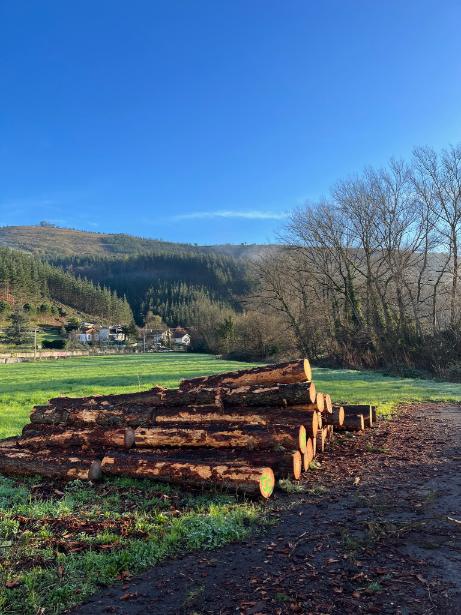
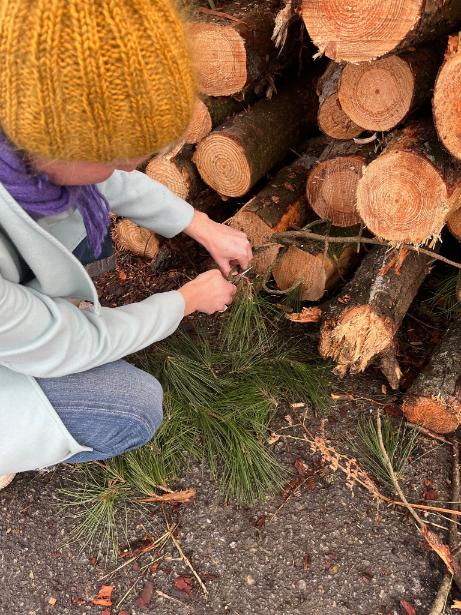 The Lambari Train station just so happened to have a pile of Pine Logs at it the first day of class in 2023! I did some foraging of the left over and found an absolute abundance of Slash even in these logs which had clearly been transported from another location. Both Needles, bark were collected.
The Lambari Train station just so happened to have a pile of Pine Logs at it the first day of class in 2023! I did some foraging of the left over and found an absolute abundance of Slash even in these logs which had clearly been transported from another location. Both Needles, bark were collected.
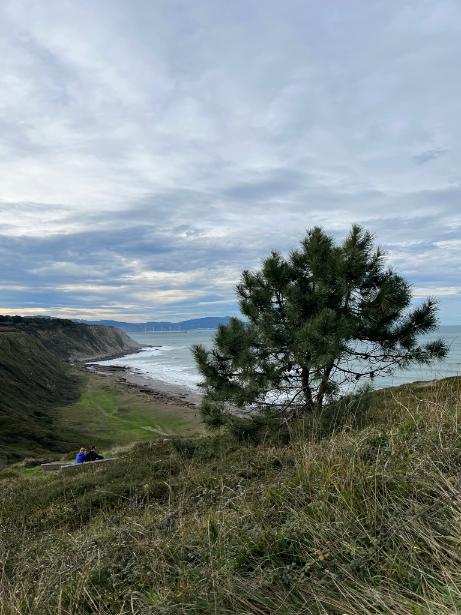

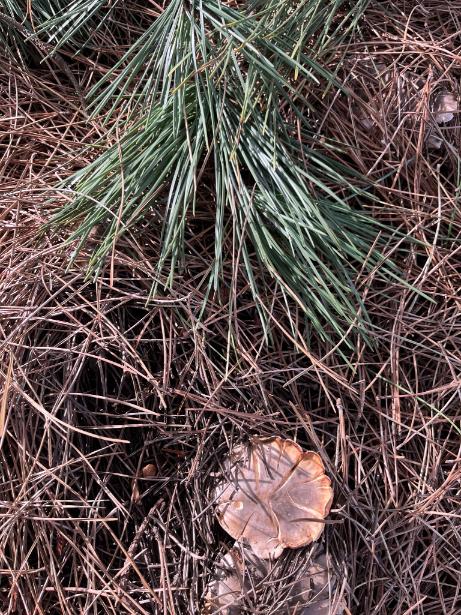
 Last weekend I went for I hike along the shore near the beach of Sopelana where there are tonnes of the variety of pine Pinus Pinaster a maritime variety of pine with really long needles. There was a dense bed of needles easily 30cm deep and large piles of needles held in trees making me feel this is a readily available material to harvest even outside of a Slash context.
Last weekend I went for I hike along the shore near the beach of Sopelana where there are tonnes of the variety of pine Pinus Pinaster a maritime variety of pine with really long needles. There was a dense bed of needles easily 30cm deep and large piles of needles held in trees making me feel this is a readily available material to harvest even outside of a Slash context.
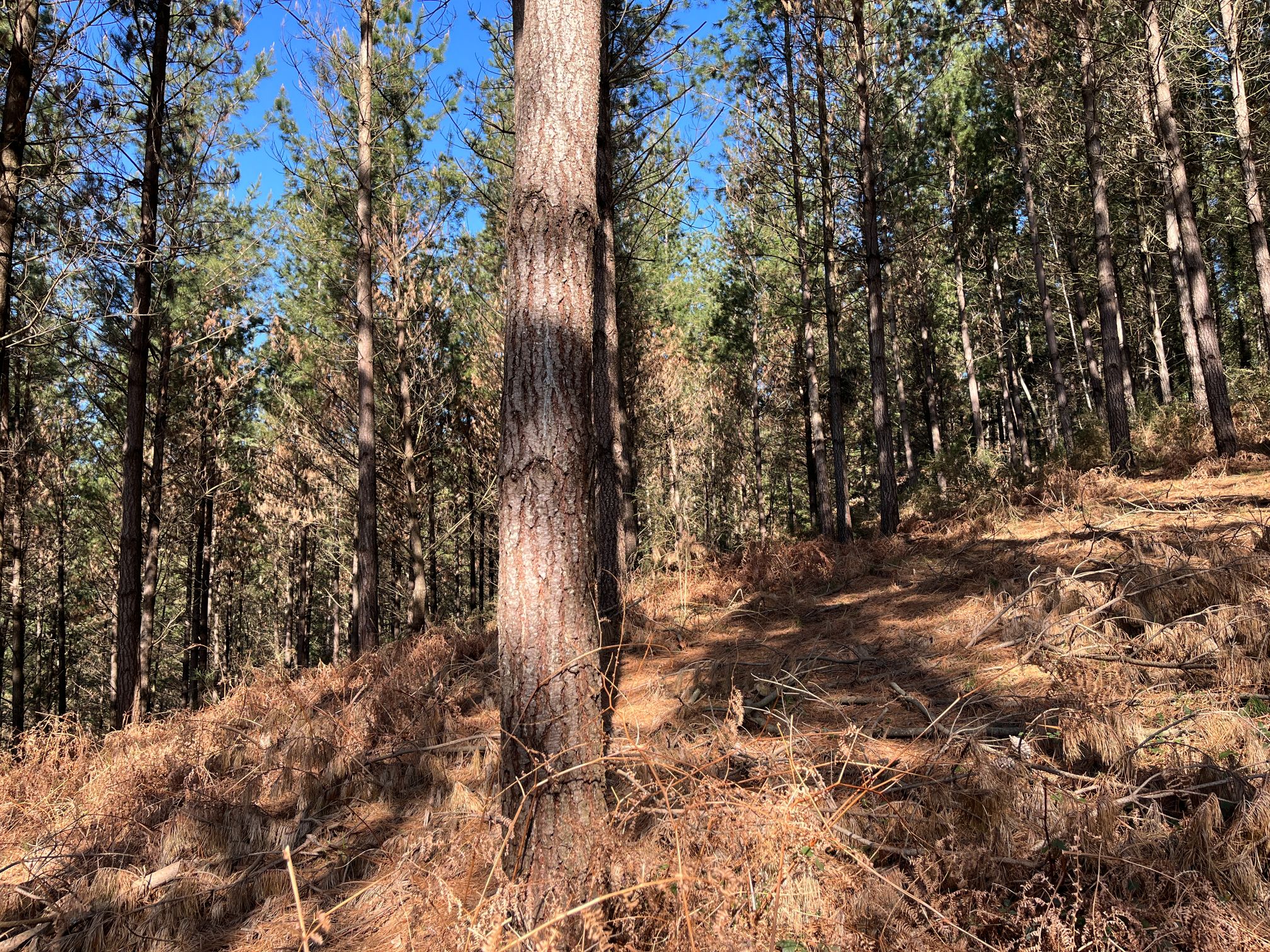

On my train ride into school I noticed a clearing - our lab director Adele Orcada connected with the town Mayer and we were able to obtain the personal contact info for the land owner. This was such a great windfall as I am now able to get as much material as I'd like from just down the road in a very true context of a clear cut.
Substrate Processing¶
The steps I have followed for substrate are taken from Mycelium Runnig
- STEP ONE:
- Chop needles in pieces. Ideal to have finer and larger chunks and for sizing to range from 1/4"-2"
- Put into fabric bag
- STEP TWO:
- Put fabric bag into boilig pot of water
- Immediately reduce heat and let simmer for 1 hr
- note: you do not want to completely sterlilize materials. Having some of the microbiome available is good for the production of healthy mycelium, hence not sterlizing completely
- STEP THREE:
- Remove substrate and spread it over a sterilized surface to all ow it cool enough that you can touch it
- STEP FOUR(options):
- Add substrate to sterile bag/petri (before of after)
- Precolonize bag with spawn
- Cover in Liquid Slurry mixture
- Add mushroom cap
- Add active mycelium
- Allow for a very small amount of O2 to reach substrate
- Add substrate to sterile bag/petri (before of after)
- STEP FIVE:
- Store in a dark area from 18-26*C (depending on the mushroom)
- Maintain at 80-90% humidity
- Ensure area remains as sterile as possible
Pine bark and needles were collected, bark broken down into smaller chunks and pine sorted for fresh needle, taken from slash and more dead needle taken from the forrest floor and hanging in trees
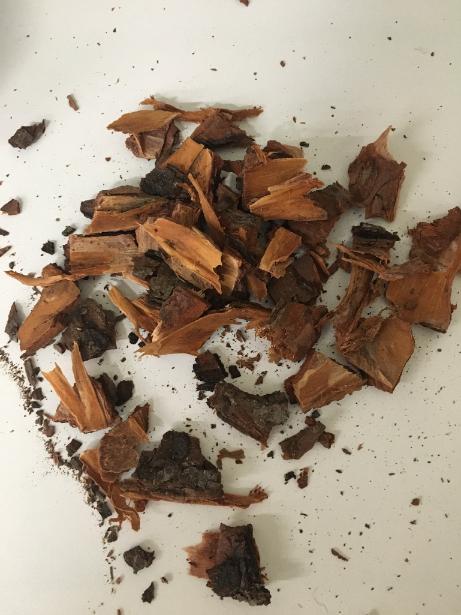

Needles were treated differently, one was immediately sent to the drier which included the already dead needles. These will be used for pine explorations outside of mycelium. The others were cleaned in a water bath in preperation for boiling.
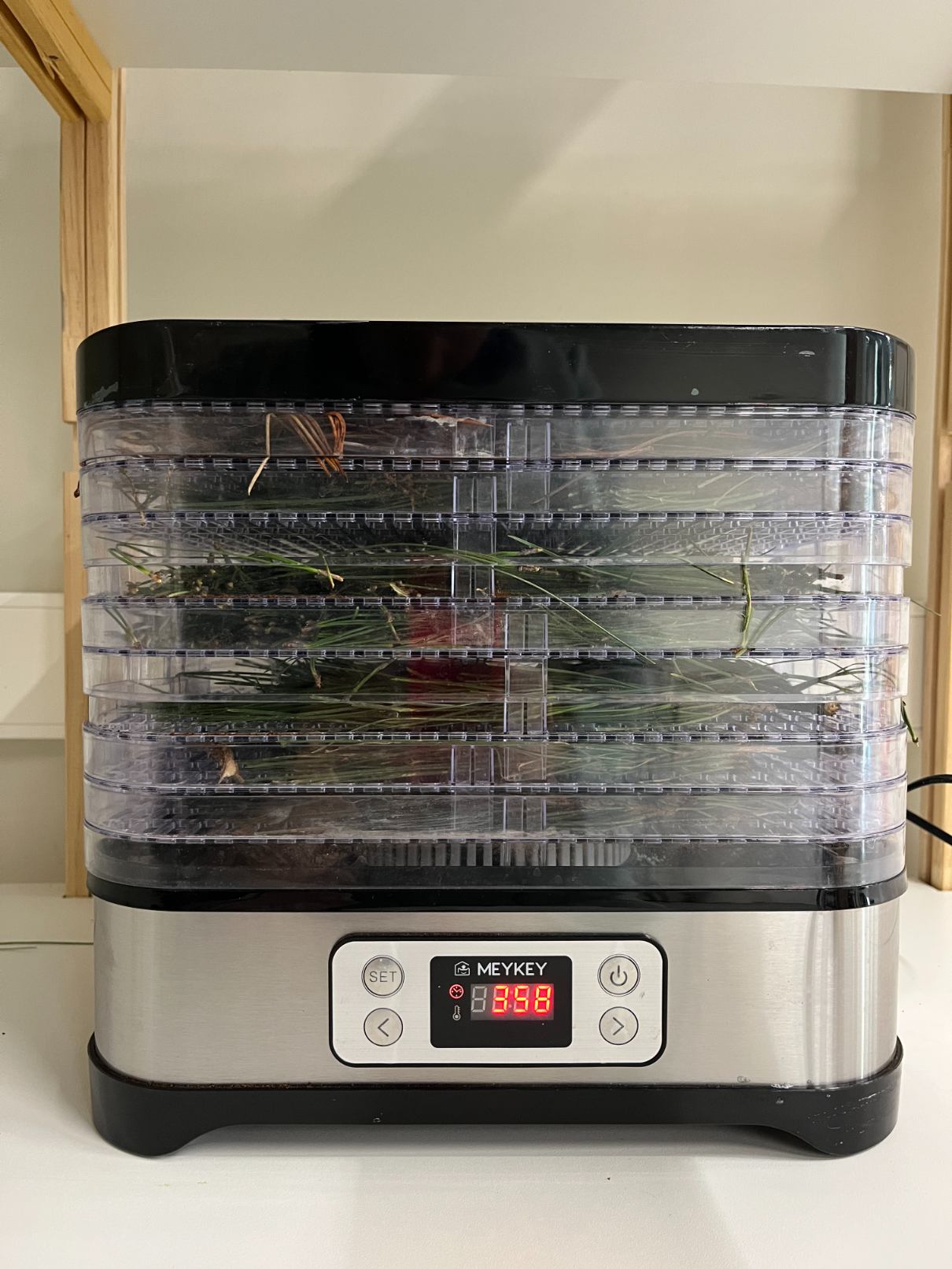
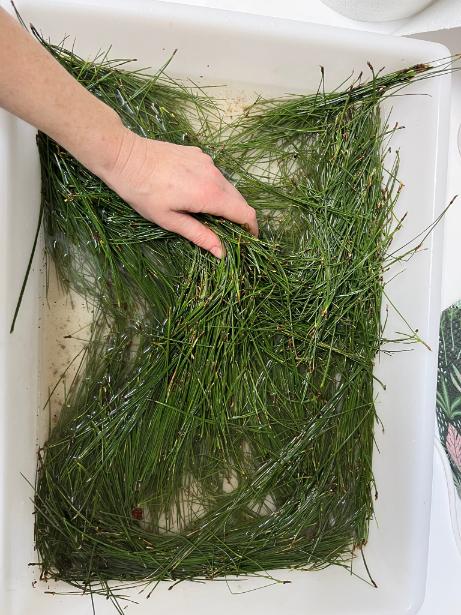
Fresh pine was used for the mycelieal substrate as organic matter with higher microbial diversity tends to do better. Cut pine and boiling bark were added to bags clipped into boiling water which was brought to a simmer and left for an hour. Final results were left to cool on a sterilized surface next to our Petri, Nutriant Agar set up for te next step!
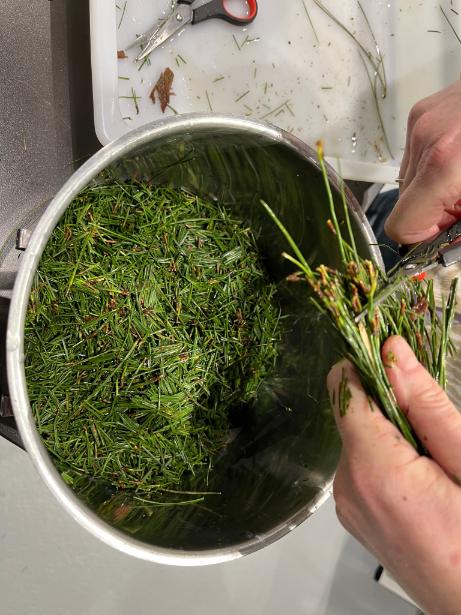
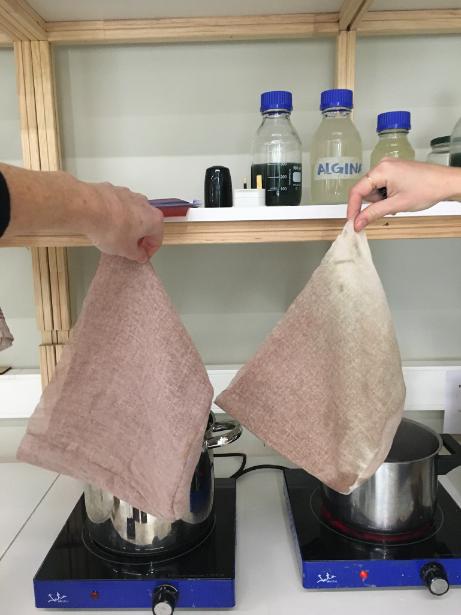
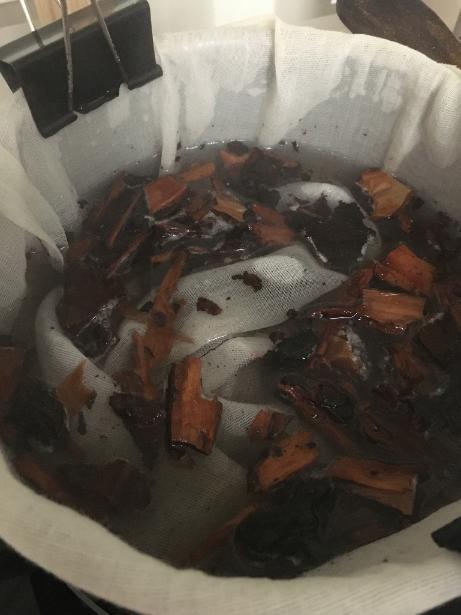

Material Innoculation¶
Following The protocols listed in Jess Dias' presentation we sanitized some glass petris, set up a couple of Agar dishes and got ready to get some things growing! For this expample we used a Lactaruis Deliciosus Mushroom that had been foraged 3 weeks prior and frozen.... we now know from our experiements that it is unlikely that this mushroom will drop any spores... live and learn.
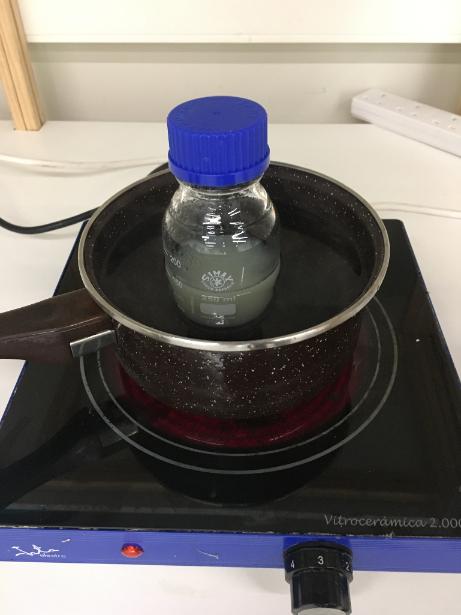
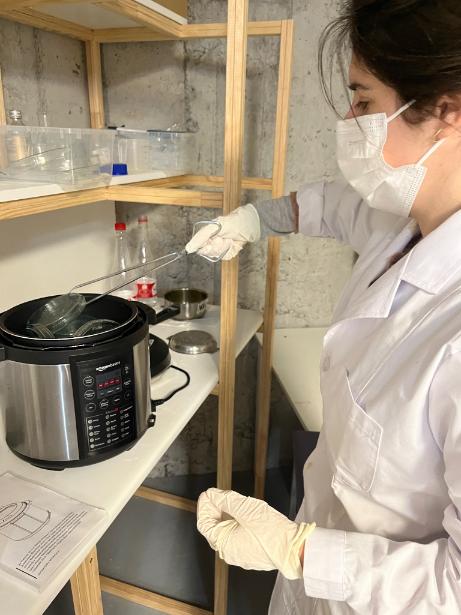


In order to get prepped to inncoulate we followed these steps:
- Heat Nutrient Agar (will use malt in future) in bath until melted, then allow to cool to room temperature
- Sterilize glass petris in pressure cooker
- Create Sterile surface and create a vaccum of air using a flame. Wear gloves + mask
- Sterilize blade in flame until red then cut triangular pieces of mushroom cap
 Samples were mixed with clean protocols in place and labled with contents, dates, and makers. then sealed with Parafilm. In the above slides you'll see we mixed the mushroom cap with different materials, but also did some experiements combining the mushroom cap with Grown.bio substrate in hopes of having some kind of a successful hybrid.
Samples were mixed with clean protocols in place and labled with contents, dates, and makers. then sealed with Parafilm. In the above slides you'll see we mixed the mushroom cap with different materials, but also did some experiements combining the mushroom cap with Grown.bio substrate in hopes of having some kind of a successful hybrid.






Spore Collection¶
We had three attempts at sport collection this week. In our first iteration we followed a protocol found online that suggested keeping the stem of the mushroom in water, another that suggested a covered glass protocol. With these first two experiements we used a Lactarius Deliciosus Mushroom which had been previously froven for 3 weeks. Both experiments did not result in spores.

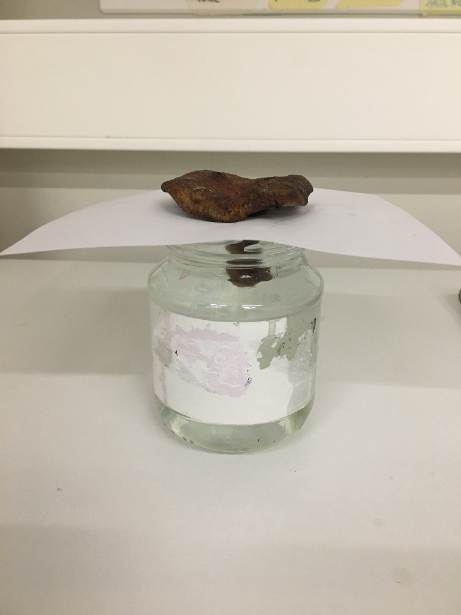
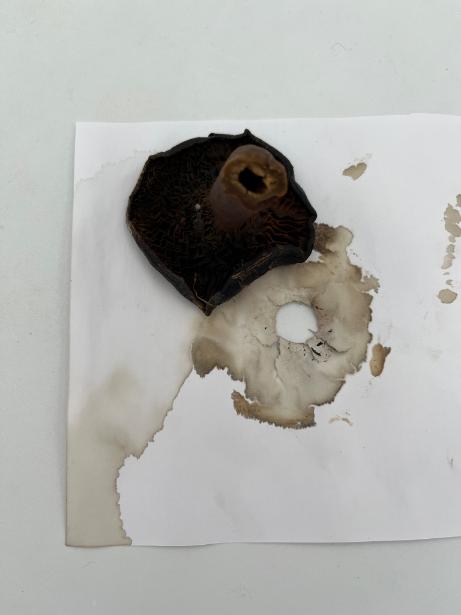
Thus I headed out on the weekend to try to find some mushrooms still growing in the dead of winter. Dios mio. I did find success as indicated above near the Sopelana Beach in a pine forest. Again my key learning here was to come better prepared. Next time I will set up more sanitary protocols for mushroom collection including gloves, a clean knive and a clean container to put them into.
Despite my failing respiratory health I decided to go for some home spore prints. I over did it on the collection - that was another lesson. I did not have black paper which would have been advisable with such a light gilled mushroom to allow for more visibility. I placed the mushrooms then covered what I could with clean glass containers in order to maintain humidity. The next morning I didn't think I had anything at all until I removed the paper and noticed some powder on the plastic sheet below. Again here I wish I had have sterilized everything in advance and had a sterile q-tip to take the sample with. Notes for next time!
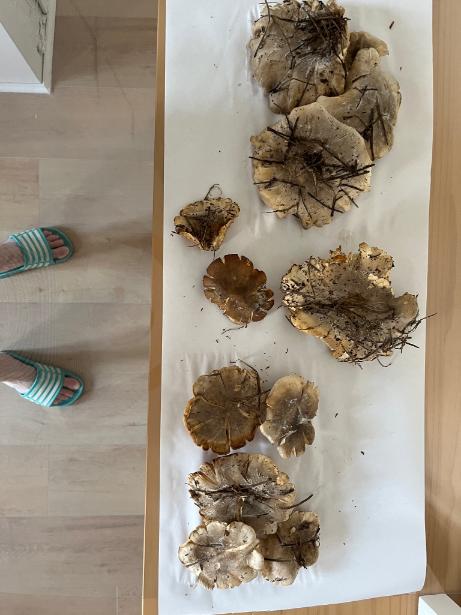


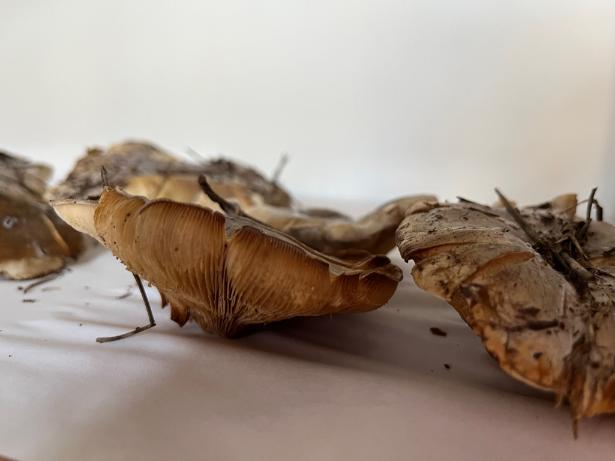
Propegating Mycelium from Wild Spores + Grown.Bio Results¶

BioComposite: Slash + Pine Resin¶

Mycelium Development: Pine Slash + Kinco¶
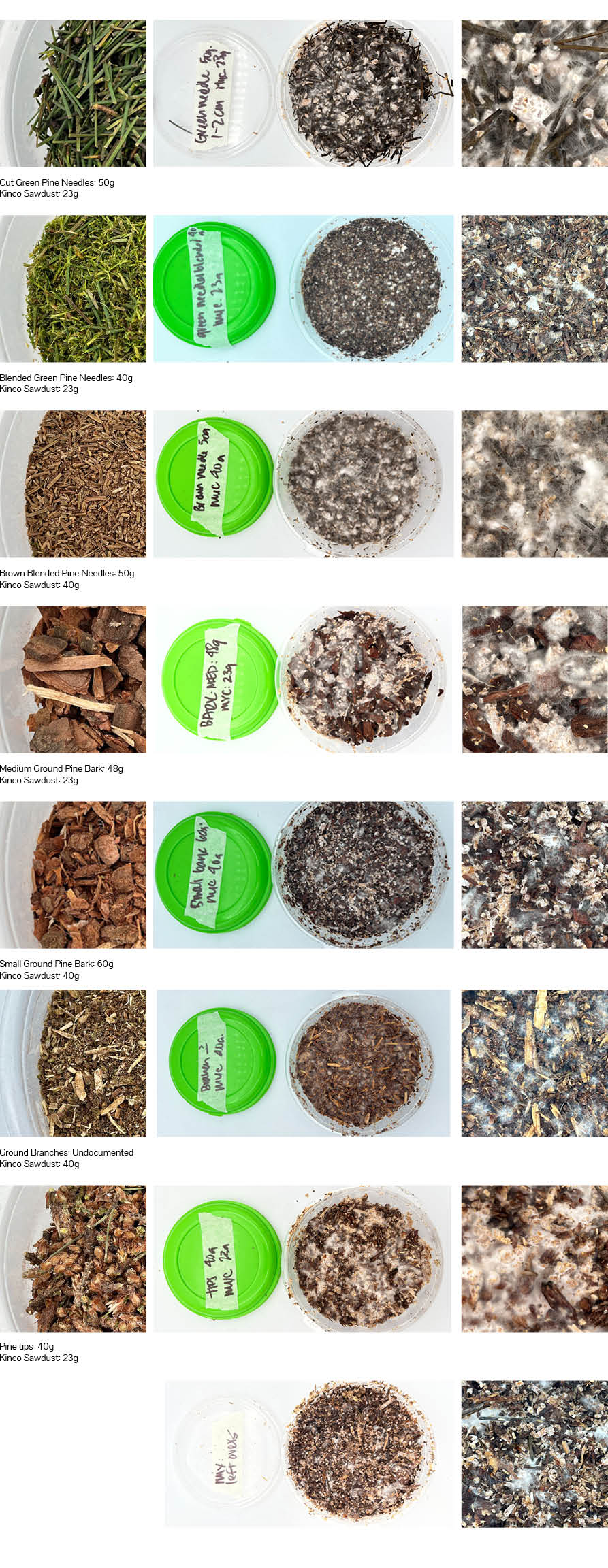
Recipe 1 Substrate 2L Brown ground needles 2L Kinco substrate 1 hour presssure cook on high
Recipe 2 Substrate 2L Brown ground needles + branches 1L Fine Ground bark 1 tbsp ground oats 2L Kineco 1.5 hours presssure cook on high
Recipe 3 Substrate 2L Brown ground needles + branches 1L Medium Ground bark 1 tbsp ground oats 2L Kineco 1.5 hours presssure cook on high
FEB 13:
- Recipe 1 created
- Bag Shaked Feb 20
- Ready for use Feb 25
- Used Mar 13
Feb 20:
- Recipe 2 created
- Substrate started
- Used Mar 6 in small scale models
Feb 21:
- Substrate Sterilized and Innoculated with Kinco and with Lactarius Deliciosus (seperately)
Mar 8:
- recipe 3 started
Mar 13th:
-Mix of Recipe 1 and 3 used for large scale model
Ideation & sketches¶
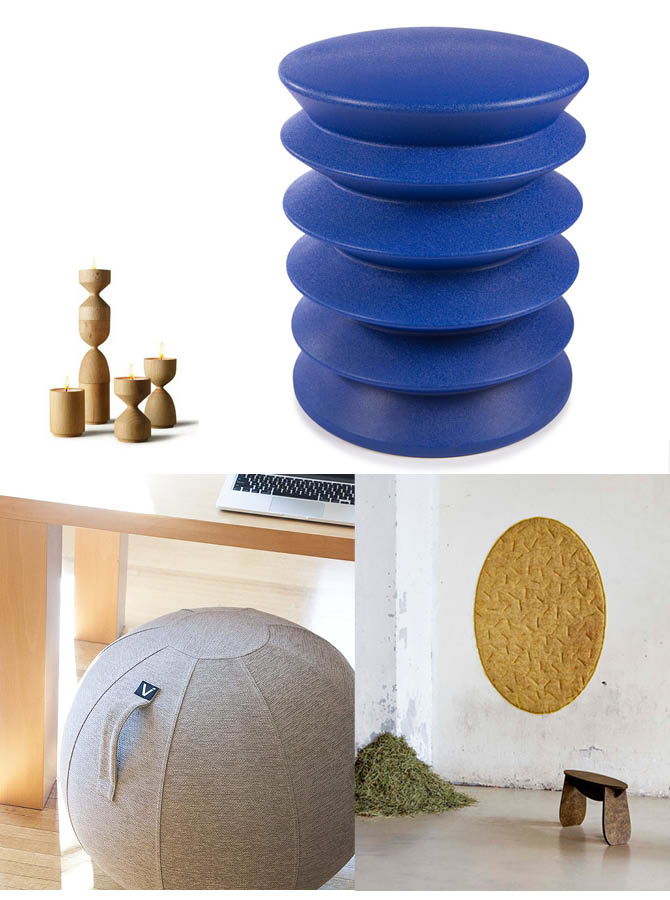
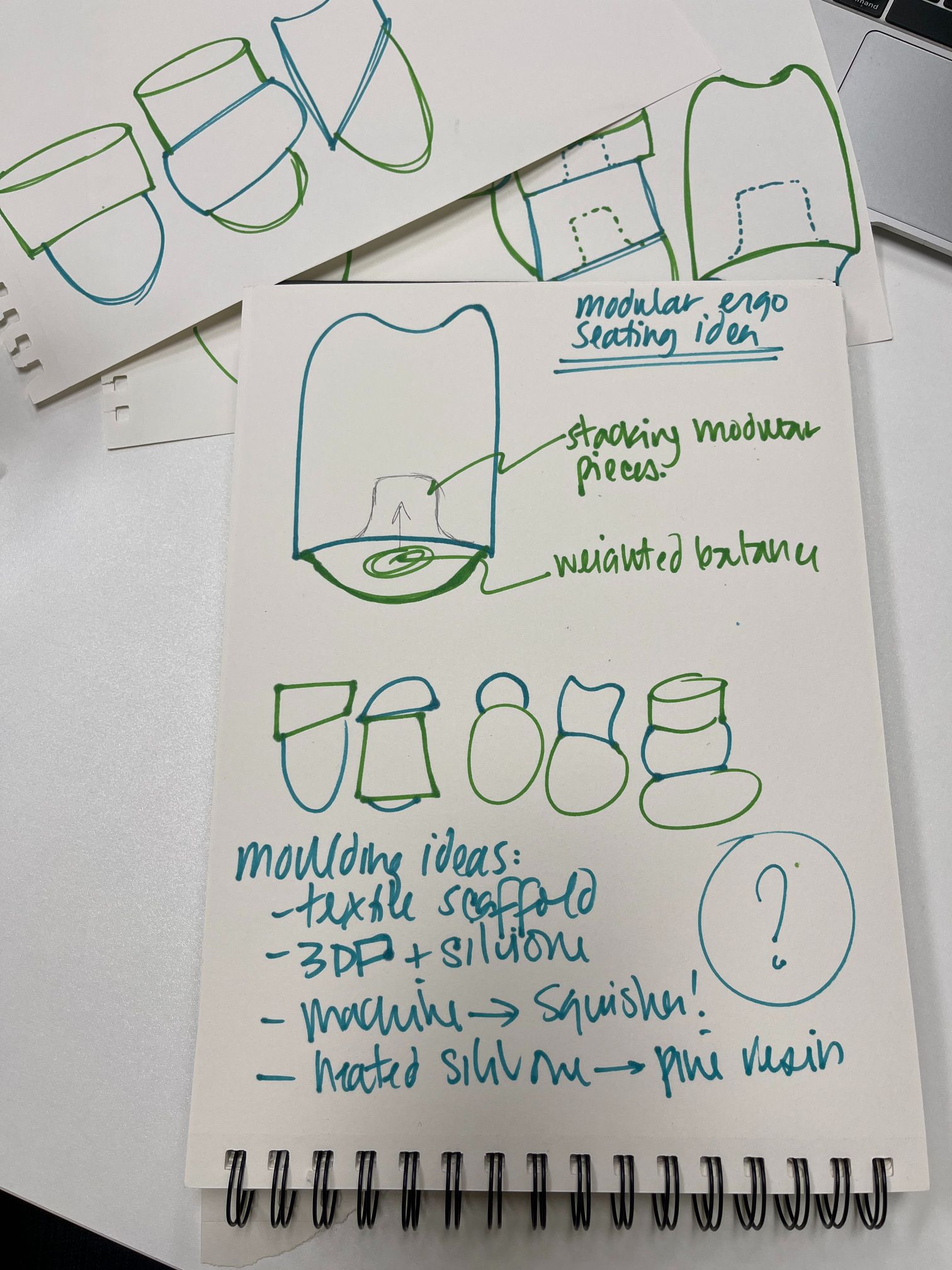
Next Steps¶
Learning
- Workshop with Catherine: Mould Making, Medicinal Properties of Mushrooms
- Rhino/Grasshopper Class
- Data source for form generation
Aesthetic
- Frankenstein Prototypes
- Moulding Process (Machine, 3d print, textile scaffold)
- Use of colour on Mycelium (paint, pigmented pine laquer)
- Deleveloping finish
Develop Biocomposites: Algae, Nanocellulose, Fibers. Understand properties of existing composites
- Algae
- Nanocellulose
- Fibers
Design & Fabrication¶
once you start designing and fabricating your first tests, you can link both at the bottom of the page with footnotes

"This step of the process was important because i learnt to draft my own pattern digitally. The first tests of this can be seen here on the right, find half- or test-fabrication files here1"
Story Telling¶
Notes from Previous Fabricademy presentation to understand how to tell my story.
- Story can help promote your project idea: Working with environments in transition: Pine Forests
- wearable bed vs "sleep warrior" - the story part of a project is what people will remembe first
- excavate or find the story, then develop a way to showcase it
- Documenting = What + How
- Storytelling = What + Why (they layer ontop of the documentatio )
- words + images + emotions
- Storytellig consists of:
- decribing a problem
- intorducing a hero (or design, or you as the designer)
- hero finding a solution
- doing all of the above logically and visually
- Storytelling is:
- concise
- moved forward by curiosity and involvement of your viewer
- POV of unknowing viewers
- predictable is boring - be unexpected
- 3s rule:
- begin with a bang
- make sure the bang can be understood within 3 seconds
- Great headline, great picture, great intro (3 sentances max with a cliffhanger)
- How to find the story of your project:
- don't go into documentation, find your why, why are you here, why you are doing this process
- what way and emotions of your engagement with your project
- what and why of your own story
- write this out on a piece of paper (ideas, motivations, and emotions)
- main idea
- because because because because because
- therefore therefore therefore therefore
- main story
- don't go into documentation, find your why, why are you here, why you are doing this process
- Don't
- use jargon
- try to be complete
- prattle on
- forget citations
- typo
- Do
- be as personal as you can
- treasure the details, zoom in, be as specific as you can
- dare to be entertaining
- be organized: chapters and subchapters within the story
- prototype: arrange and re-arrange
Fab References¶
- use of micro shots and process
- calm but active piano music sounds fragile, emotional and urgent
- using music with text to create impact
- busy photos interspersed with simlified colourful graphics
- chapeters
- fast ands slow of process
Project Storyboard Ideation:¶
Main idea: I want to design playful home objects out of the waste materials of environments (pine forests) in transition Because:
- I struggle with focus, my mind is so busy
- my whole body needs to be engaged in order to feel grounded
- the world is overhwhelming
- so much is changing
- we are literally on fire
- there is a build up of biomass in the forest
- we are not allowing nature to be itself
- nature is in the same boat as me: showing it's overwhlem for not being able to be itself
- we are controling nature
- we cant control ourself
Therefore:
- engage the with the whole body of nature in order to ground it - work with the connective tissues of it's body (myco)
- build intentionality into the everyday
- foster agency to rebuild - home + environment
- let play lead to intentionality
- play into true nature
Main Story: Play into true nature
1) (WHAT) The project: weik: Play into true nature 2) (WHAT) Seating for balance 3) (WHY) Design for grounding bodies (planet/humans)
- restore ecosystems in transition: rebuild relationships and tell story of mycelium and trees
- ground the body in order to live more intentionally
-
play into a new reality Inspiration and State of the art: timeline of projects/research that is relevant to your state of the art 4) (WHY/WHO) Numbers/statistics
-
climate crisis: forests
- biomass
- soil degredation
- fires+floods
- Reincarnation: Wood wide web
- stabilization, resource support, regeneration
5) (WHY/WHO) References: Case studies and existing similar projects (4 max)
-
pending have but not here yet 6) (for WHO) Case study - user experience, make an assumption of a person (character) that uses it (if applicable)
-
for people with busy minds
- for people who need to engage their body
- for people struggling with overwhelm and lack of focus
-
for FUN PEOPLE 7) (HOW) How does your prototype/project manifest your idea, what it tackles, improves or changes from the state of the art
-
scaleable re-usable textile scaffolding manufacture process for design of home objects
- playful intentionality in engagement with climate crisis
- use of slash, namely pine needles as mycelial substrate
8) (HOW) Technical research: Outline of how it materializes the goal/focus of the project
- seeking scientific partnership: developing circularity through localized myco remediation from biomass source
- fostering agency and intentionality within the home environment
9) (HOW/DOCUMENTATION) User manual if it is a machine or kit 10) Message to the world: what is the project's message? Define the future possibilities of the project in one line.
- playing through the transition into presence
Narrative:¶
Intro to problem:
- the world feels like its spinnig out of control
- specific examples in forestry
- i feel like I'm spinning out of control
- moving faster and faster
- being clutzy
- feelings of overwhelm
- designing with environments in transition, weik offers a way to play into nature; grounding into presence
Hero: Re-imaging a future through natures great reinarnator; mycelium. Reconnecting forest at their root. Reconnecting scattered people; re-balancing and grounding people within their home environments
Solution: Grounding stool
- Materially reconnected
- slash collection
- localized solutions for soil regeneration: attempts at local spore harvest
- myco substrate development
- biocomposite devellopment
- Grounded form
- textile scaffolds and mushroom farming
- mould re-use
- design for balance
- agency to re-build: build intentionality into the everyday
- play
Seeking: Partners from scientific realm to develop localized solutions for soil regeneration from area of biomass collection
Visual/Acoustic Style¶
Visual style: Fast, slow + BRIGHT
Multiple camera angles for process shots inspo:
Canva Storyboard draft¶
weik by Lisa Boulton
Story Boarding Voice over¶
I stared my storyboarding by developing my story first as I'd created a tonne of documentation throughout the process an now needed to edit and contextualize the footage that I had into a narrative. Each number represents kind of a chapter in the story that I told.....
- Intro Spinning forest Slash TEXT Weik + logos NARRATION Symptoms of global imbalance are everywhere; felt in our bodies, borne into consciousness and made visible in our relationship with nature. In our attempts to control ecologies, we have created an unnatural dynamic of excess and absence inside ourselves and in the wild; a build up of stressors and erosion of natural connections.
We are in the midst of a global transition and so we must learn to move with it.
-
Balance: forms Spinning Plaster prototypes TEXT Seats for Active Stillness NARRATION The world feels like it’s spinning. Finding an embodied balance takes intentionality and grounded presence.
-
Lisa head poke TEXT: Relational bio-designer, and over thinker and clutz. NARRATION: Especially… if you’re me.
-
IOT Mushroom to forest shot TEXT: IOT: internet of Trees NARRATION The forest teaches how self regulation might grow through con-regulation.
Mycelium is an underground fungal network which carries nutrients, messages and hydration between trees. When locally sourced, repopulating Mycocultures can support accelerated forest regeneration in impacted areas while stabilizing the soil.
-
Material Creation Collecting BioMaterials TEXT NARRATION Current forestry practices are disrupting the Wood Wide Web and leaving forest floors overwhelmed with excess biomass. This is resulting in unprecedented fires, floods and landslides globally. Aiming to restore the interrelations of eco systems in transition, remnants of trees were collected from locally logged land. Future developments look to work with local mycelial cultures from the areas where biomass is harvested, reconnecting familiar friends and offering land stewards with means to rebuild with local cultures.
-
Making Substrate Quick edit of making substrate Gif myco growth TEXT NARRATION 21s Creating a series of tests using the 20-30% of the tree which remains on the forest floor after harvest, allowed nature to lead the way in material production. The resulting materials were monitored for density, durability and voraciousness of growth.
-
Creating biocomposites TEXT NARRATION 12s Developing 100% pine biocomposites to complement mycelial forms added durability to the design while maintaining the stool’s intention of biodegradability.
Form VIDEO Plastic bags growing mycelium Spraying alcohol - wiping surfaces Gus gus? Model making process TEXT NARRATION Designing with nature while working to foster growth outside of a natural setting requires a very sterile environment.
VIDEO Plastic bags growing mycelium Spraying alcohol - wiping surfaces Gus gus? Model making process TEXT NARRATION Hanging in the balance, fabric molds were created to be suspended, a practice also used in the farming of mushrooms. In order to reduce the impacts of production, flexible molds were developed that are both reusable and re-formable.
Conclusion NARRATION The concept of balance is at the heart of this project; how we might ground our bodies and weave our production back into the interrelations of true nature.
Prototypes¶
prototypes are your first step towards shaping your final piece, product, material et cetera

Lorem ipsum dolor sit amet, consectetur adipiscing elit, sed do eiusmod tempor incididunt ut labore et dolore magna aliqua. Ut enim ad minim veniam, quis nostrud exercitation ullamco laboris nisi ut aliquip ex ea commodo consequat. Duis aute irure dolor in reprehenderit in voluptate velit esse cillum dolore eu fugiat nulla pariatur. Excepteur sint occaecat cupidatat non proident, sunt in culpa qui officia deserunt mollit anim id est laborum.
\